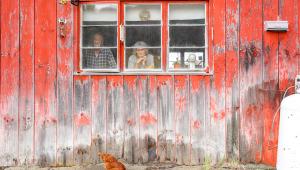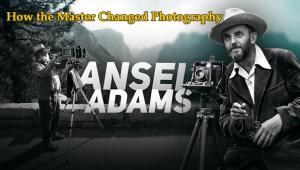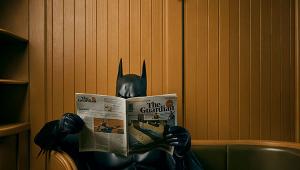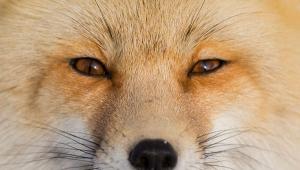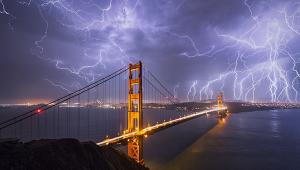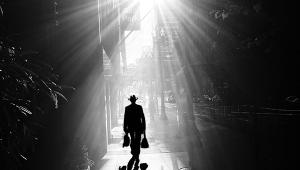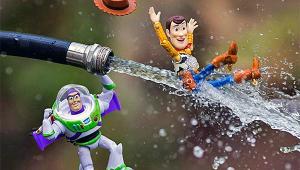Pro's Choice: The Photography Of Rod McLean: Outdoor Adventures & Active Lifestyles
“The first questions I ask myself, after receiving the layouts from the art director, are: how can I make this my own, what can I add to it?” Active lifestyle photographer Rod McLean continues: “When we select the final locations and talent, the ideas become clearer. During a tech scout, we’ll shoot various views of the location, create rough comps, and talk about the possible scenarios: the best time to shoot, the props and wardrobe, etc. We all have to have a clear idea what we’ll be shooting and how the final images are going to look because we’ll be setting up the first shot in the dark, waiting for the morning light.”

As we well know, ads often convey a message indirectly. In this case, that message is endurance, to promote an eye-care medication. “We had guides that were always one step ahead of us, setting the routes and then helping me quickly get into position, usually no more than 20 or 30 feet up. During the entire time that I’m shooting the climber, full frame, I’m also shooting foreground and background elements: mountains, river, rope, and the rock face, which is maybe 15 or 20 feet from me.” The location is Smith Rock State Park, Oregon. (Creative Director: Tom Dickman; Art Buyer: Colleen Heraty; Agency: CAHG.)
All Photos © Rod McLean
The Long Journey Home
Rod McLean has come a long way since his days shooting studio portraits as a student at Providence College, Rhode Island, and afterward as a photo assistant in a product studio. After venturing outside the studio in 2005 to work on his own, McLean has rarely stepped back inside a studio. But to reach this point McLean followed a circuitous route that involved fashion photography in Paris and, when he’d decided to take a breather and reevaluate his photographic ambitions, a stint in the Peace Corps in Africa.
Upon his return to the United States, McLean settled in Boston. That’s when he came upon the work of photographer John Huet. “Huet would shoot with anything available to him,” McLean relates, “exploring everything, without being limited by specific guidelines.” McLean was now assisting Huet and several other location photographers in the area, and this experience spurred him to not only expand his vision but also his own camera gear. He was shooting with a range of gear that included Graflex Super D, Speed Graphic, Wista, Cambo, Pentax 6x7, Canon, and even pinhole cameras.


This company manufactures anti-glare sunglasses that are used by sportsmen and photographers alike. “The idea was to place adventure sports photographer Jimmy Chin at a river crossing on a photo expedition amid the imposing vista of Smith Rock State Park.” To get close enough to Chin to shoot full frame, get the low angle, and be able to move around, they brought along a 20-foot aluminum ladder, which they used as a bridge into the middle of the river, rigging it to the rocks. Then they moved the whole rig further downstream to get the foreground water and rocks. Initially, Chin was shadowed by the mountains, so McLean set up a Profoto 7b to highlight him, but by the time this shot was made, sunlight was coming over the ridge just enough to make the 7b unnecessary. “When the sun hit him full on and the highlights became too hot, that was my signal to call it a day.” The supporting image shows the various elements that were used in the final composite. (Executive Creative Director: Andrew Price; Art Director: Amy Kitt; Art Buyer: Heather Levine; Agency: Factory Design Labs.)
Keeping Pace
Over time, McLean gravitated toward Canon EOS digital cameras. He now works with the 1D X and 5D Mark III. The lenses he uses most often are the 24-70mm f/2.8 II and the 70-200mm f/4 IS, although he also carries an 85mm f/1.2 and a 50mm f/1.4.
McLean prefers to shoot at a fast clip—hence his preference for the 1D X on most shoots. “When you’re shooting athletes, things are constantly changing. You have to capture a lot of frames, and you have be mobile and adjust to the situation.” He carries an Ewa-Marine housing for when he’ll be shooting with the 5D underwater (for which he has a beat-up 24-85mm). On land, he may use an inexpensive Calumet monopod on occasion, but also brings along a Gitzo carbon-fiber tripod.


This ad campaign promoted the company’s Stand-Up Paddleboards (SUP); hence the Lake Tahoe, Nevada, setting. It was a four-day shoot, during which McLean took his camera into the water. At one point, and because McLean was shooting tight with a 24-70mm lens from underwater, with the camera in an Ewa-Marine housing, the passing board clipped the housing port. For the surface shot, he “played it safe,” lying on a neighboring paddleboard, sans housing. “I’m rapidly shooting multiple shots of her on the board, the water in front, and the wake behind for the final composite.” (Creative Director: B.C. LeDoux; Agency: Glen Group.)
McLean’s Modus Operandi
The composite image is at the core of McLean’s work. “I build the image one piece at a time to recreate the same perspective that I originally saw upon viewing the scene with the naked eye,” he explains. “I shoot big, wide shots and I don’t want to change that perspective with my choice in lenses or distance from the talent. So I’ll shoot the foreground and background in multiple pieces in 50mm. Then I’ll stitch those background pieces together. And then I shoot the talent at the same location, but coming in closer and also from a 50mm perspective, filling the frame with the athlete.”
So, why does he need zooms? “When I’m shooting a majestic sky, I will shoot a wide shot—I’ll do four or five shots at 24mm and stitch those together. That gives you an almost coming-over-the-top-of-your-head feeling.” And of course sometimes you have to zoom in to capture the details.
One advantage to compositing is that it creates huge files, which his clients appreciate. “I do the compositing myself, and a retoucher adds the finishing touches.” He mostly works with Adam Moore (Sugar Digital) and Scott Dorman (Smalldog Imageworks).

“We needed to shoot Erik Skaden, an ultra-marathoner with Team Montrail, showing him running under the adverse conditions he competes in. A spring snowstorm was predicted, which would be perfect for our first shot, but en route to Tahoe, the storm pounded us. Visibility was nil, so we decided to pull off the road at the nearest park and just start shooting. The snowflakes were so big, they interfered with autofocus. We were done just as the storm ended.” Next, McLean headed south to photograph the runner in rain, mud, and water, to further illustrate conditions the clothes were designed to tackle as part of this ad campaign. (Marketing Director: Chris Strasser.)
Location Lighting
“Almost everything I shoot is backlit. Another advantage to compositing is that it allows me to separately expose for the talent and the background. This way, I don’t have to add lighting on a large scale, if at all. As an adjunct, I may fill the talent a bit with a Westcott Scrim Jim, with silver or custom silver/white panels, and I may scrim the sunlight a little, if the highlights start to blow out.”
When he does light, usually on a cloudy day, at dawn, or dusk, it often involves mixing ambient with strobe, using a Profoto Pro-7b set up with a Magnum Reflector, usually 15 feet up in the air and 20 to 25 feet behind the subject, to highlight the subject in place of sunlight. As fill, he may turn to an Elinchrom Octabank connected to another 7b, bouncing additional light with a Scrim Jim.
“Because these are athletes—and there’s usually a lot of movement involved—I prefer to keep exposures to at least 1/400 second, and certainly not longer than 1/250. And I stop down to f/5.6. Another key reason for me to use the 1D X is that I can shoot at ISO 1000 and still get a clean image.”

“This campaign began in Ireland with another golfer, and now we were in Baja California Sur, Mexico, with pro golfer Ricky Barnes, promoting the client’s golf attire and sunglasses. We usually tech scout with the aid of an app called Sun Seeker (available for iOS and Android) to determine the best time to shoot at each location. With this blazing sun, there was no best, or worst, time. We had to scrim everything with a 20x20-foot silk overhead, adding multiple Scrim Jims for bounce and 4x4-foot silver reflectors to backlight the talent, plus a 6x6-foot black shade for the camera. We would shoot from sunrise to about 11am, then take a break when the heat was excessive, and returned to shooting from 2pm to sunset. After we were done, I stayed around for a couple of days to shoot background and foreground elements.” (Creative Director: Josh Willis; Art Director: Bryan Cavanagh; Art Buyer: Jill Groves; Agency: Factory Design Labs.)
Scouting, Permits, And Gear Rental
Location scouting for McLean is generally a collaborative effort between him and the agency. “Budgets don’t always allow us to scout multiple locations for each scenario. We’ll pull images from our files or off the Internet, narrowing down the locations, so we know where to send a scout. Usually we have a couple of location changes in a day. So when looking at locations we need to consider what will give us the most options, how easy is it to get to the various sites, and where we can get permits quickly.”
McLean continues: “Everything involves permits, because we’re going in with a big crew: three assistants, a producer, production assistant, the client (that’s two or three people), and agency (another two or three people). We’ll sometimes use a motor home.
“And we rent a one-ton grip truck. You never know what you’ll need when you get there. Weather conditions can change dramatically, especially in the high country.” McLean adds: “Everything is rented on site. In remote locations, we’ve had to bring in grip trucks from the nearest rental house hours away.” What he does carry is usually limited to a couple of bags with his own gear.

“I was running in Dyrehaven, a park outside Copenhagen, when I saw this woman riding. She’d agreed for me to photograph her, so I returned a couple of days later, spent an hour photographing her, and then another couple of hours shooting the background elements. The sun was constantly breaking through the clouds, lighting up different parts of the scene that I also wanted to bring out in the composite, since I initially exposed for her as the key element in the image.”
“We always bring a carnet for the equipment that we take with us when working on an international shoot. The producer handles all of that. We just show up early enough before departure for Customs to complete the paperwork.” McLean concludes: “In many foreign locations, it often turns out that among the production crew you’re working with, someone has a pro D-SLR similar to yours, which he’ll let you rent.”
Leaving the confines of the studio taught Rod McLean to appreciate the freedom and inspiration that the open spaces give him. And he’s never looked back. McLean is currently based out of San Francisco.
To see more of Rod McLean’s work, visit www.rodmclean.com.




